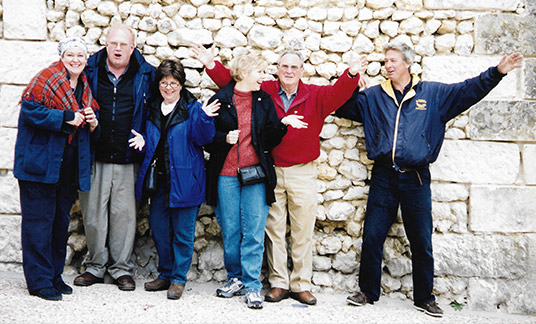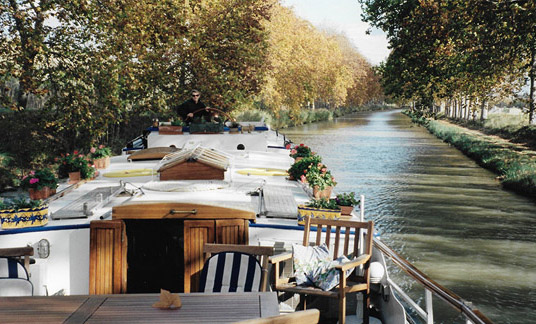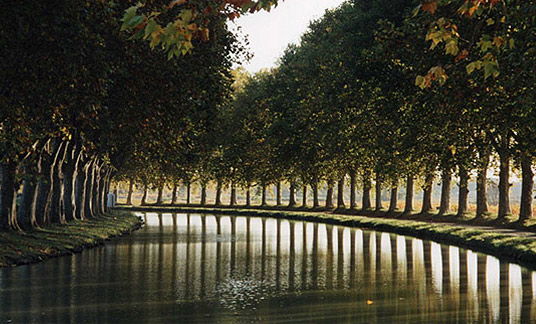Memories Are Made Of This
* We award European Waterways our Most Outstanding Experience accolade. Of all of the travelling we have enjoyed, none has given us more comforting satisfaction and genuine yearning to do it again. We have sampled the cut-above canal barging experience with them in Burgundy, the Loire Valley and Languedoc (the Canal du Midi) and each has delivered the same joyful ‘that was simply superb’ reaction. Very happy to recommend them to everyone and frequently tell friends, work colleagues and family that this is something they all must try.
SOME memories are so strong and memorable they will stay with you for the rest of your life.
Autumn, no question, is the season. Place me anywhere in that period between August and November and I’ll be in fine fettle.
If that happens to be the Languedoc region of south western France, you can safely multiply the satisfaction factor by five.
If there’s an hotel barge on the Canal du Midi involved, with great travelling companions as well as all of the other sumptuous trimmings, then I am guaranteed to be the very mellowest of fellows.
The clear, September air carried the occasional scent of woodsmoke, so evocative it heightened your senses. It is one of the most primitive smells in life and consequently, almost extinct.
The memory, as I said, has lingered for many months.
Everywhere we glanced through seemingly endless lines of plane trees which in Summer, shade the banks of France’s most famous inland waterway, silver wisps entwined in pleats and floating layers hung in the air to signal that winter was just around the corner.
In the flat and open landscape of Languedoc, this is an annual ritual, the wine producers and farmers all tending little smouldering bonfires of pruned vine clippings as they tidy up after harvest preparing for the cycle to start all over again.
Aboard the fine old barge Anjodi, which is doing its level best to ruffle the still waters ahead of us (and almost failing at its slo-mo 4km-per-hour chug), Captain Roger Gronow tells us this too is his favourite time of the year.
He sees the canal in all of its varied moods from Spring when it slowly re-stirs into life, through Summer party time when the self-hire “noddy boats” piloted by weekend amateurs and others jockey for position to reach the locks, causing much tut-tutting from the professionals.
Unwinding pace
Autumn, when things inevitably begin to slow down, brings with it an unwinding pace which is quite a relief and something to be relished for a fleeting few weeks.
So here we are, lying back up on deck, the strangely comforting muffled thrum of Anjodi’s engine just barely audible, being treated to spectacular glimpses of rural France not visible in high Summer when the lush canalside undergrowth forms a tunnel of greenery and provides a welcome dappled shade.
If it was necessary to describe the scene in a single word, it would be quite simple…
Bliss.
The astonishing Canal du Midi, recently granted World Heritage Site recognition due to its uniqueness, was a realisation of an almost Utopian project – to link the Mediterranean to Toulouse and the Atlantic – by the formation of a navigable route.
It is thanks to the vision of Pierre Paul Riquet, who applied all of his energy and means to the accomplishment of his grand design, that it is possible for people like us to be soaking up the atmosphere and still travelling in style – over three hundred years later.
The ingenuity and solutions he designed to overcome technical problems and natural obstacles that lay in his path, fully justify its recent recognition as a very fine canal indeed.
Some twelve thousand workers toiled non-stop on the engineering feat which took fourteen years to complete. Sadly, the task took its toll on Riquet who died just six months before the official opening.
What survives today is the greatest monument possible to the man, combining function and aesthetics in classic style.
Its greatest attraction for those with an urge to hop off and step ashore is the rich diversity of places of interest along the way, from the fairytale pinnacles of Carcassonne to elegant Narbonne, once the capital of Rome’s first colony in Gaul, with tree-lined streets and esplanades so attractive, window shoppers can’t help dawdling.
Idyllic perfection
The week-long cruise includes a visit to Beziers, the capital of Languedoc wine country, where a third of the country’s output originates, and Capestang with river and canal craft of every shape, size and vintage, tied up and mostly going nowhere, thanks to the idyllic perfection their owners have discovered there.
The entire region is steeped in the tragic history of the Cathars, the sect which, when hounded to extinction, took refuge in the castles and fortified hill towns and were proscribed as heretics by Pope Innocent III in the 13th Century. Nowehere is their story told more powerfully than in the little museum in Minerve, sitting at the very heart of Minervois wine country.
Clinging precariously to a weather-worn outcrop of blonde standstone, between the gorges of the Cesse and Briant Rivers which in winter thunder past to merge as an eroding force at its base, this place may look peaceful now, but the air of stillness conceals a wicked past.
It was here that the notoriously cruel Simon de Montford decreed that the inhabitants would be given one final chance to join the Catholic Church or face death following a seven-week seige.
The Cathars declined and, abhorring the materialism and power of the established church, and proclaiming instead the simple Christianity of the Sermon on the Mount, said the option to stay in the physical world, inherently evil and the creation of the Devil, was not for them.
As a result, de Montford and his men continued their relentless campaign to hound them to death. And, on July 22, 1210, a massive bonfire was lit outside the little chapel and each of the 180 Cathars chose to seek salvation by stepping into its flames.
Another extraordinary site seven kilometres southwest of Beziers, is viewed from the 2600-year-old Neolithic settlement at L’Oppidum d’Enserune, later inhabited by the Romans, who devised an immense cartwheel-like water-gathering system at the foot of the hill as a giant storage basin.
Unique landscape
Today the Etang de Montady is drained but local farmers have retained its form and still cultivate the tapering radial pattern of fields and the central circular hub to provide a unique landscape and one which is unsurprisingly photographed widely throughout its changing seasons – and frequently from the air.
As the barge completed the six-kilometre stretch to Capestang, to the raucous welcome of the local duck mafia who approached mob-handed and quacking furiously for titbits, we hopped off for a cycle along the towpath to give the place a quick once over.
Then, it was all aboard the mini bus for the first long-awaited tasting at Chateau de Raissac, where they have been producing some of the region’s outstanding wines for five generations.
There are cases of deliciously fruity Chardonnay on sale at these caves for around unbelievably cheap per bottle rates which can be found in some of the better wines shops of the UK for over five times the price.
Later, at dinner onboard, they let us sample the best the cellars had to offer. European Waterways have gained a fine and well-deserved reputation in the thirty six years they have been entertaining clients to the tastier side of life in France.
Friends from California who had been onboard Anjodi the previous season and rhapsodised about the food and wine served up at meal times, received a quick e-mail on my return.
It said: “Thankyou, Thankyou, Thankyou. That’s one we owe you.”
* Pic below shows another group of happy European Waterways customers with Brenda (left) and head skipper extraordinaire Leigh Wooten (right).
For reservations or more information, including full-colour brochure, contact the team on 01753 598555 or visit the https://www.europeanwaterways.com/ website






